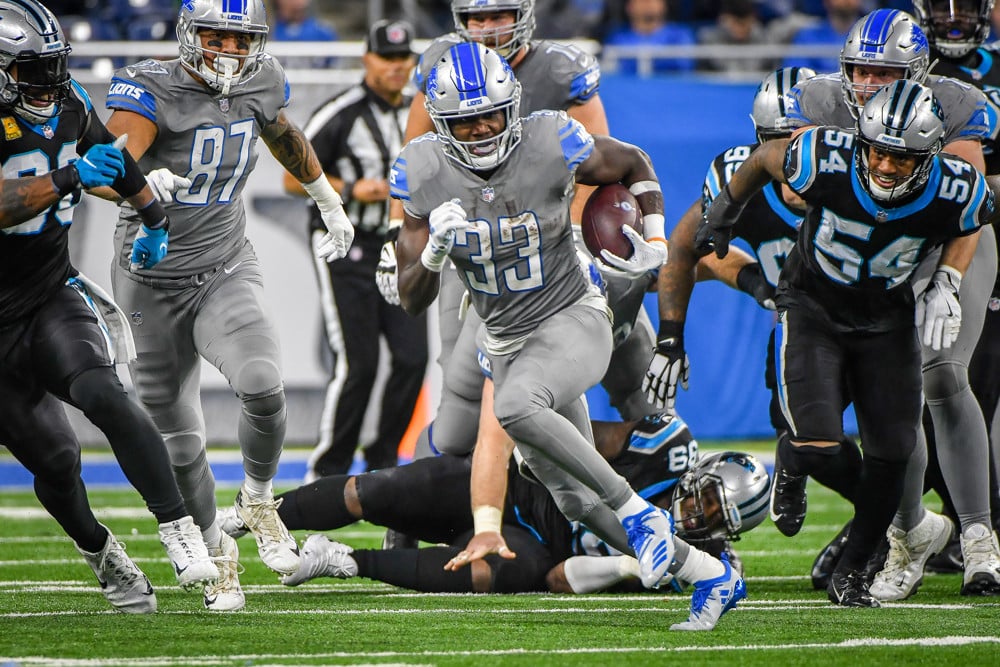This is Part 3 of my Zero RB target list. So far I’ve covered RBs in the early rounds, and in Rounds 7-10. Below I’ve highlighted targets in Rounds 11-14 — the last tier of RBs before we get to the pure flier selections.
To find the right RBs, I’m using the key takeaway from my article on historical hit rates: over the last 5 years, 80% of RB hits had a season long pace of at least 20 carries inside the 10 yard line (green zone) or 3+ receptions per game. Therefore, we’re looking for RBs with paths to significant goal line roles and/or receiving work. And, although this gets harder to find deeper in the draft, we’re looking for RBs whose paths to a valuable workload aren’t dependent on an injury ahead of them on the depth chart.
Editor’s Note: The NBA is coming back and we are launching a brand new product! Led my Drew Dinkmeyer, we will bring you Tiered DFS Top Plays, daily matchups column, continuously updating Depth Charts and tons more. Click here for more info.
New Round 10 Target
Zack Moss, ADP: 10.03
Moss was originally on my Round 10 target list, but I bumped him from that group before publishing. Since then his ADP has increased. So has my interest.
The reason for his original demotion is that Moss doesn’t perfectly fit the zero RB target profile, with red flags in both the receiving game and on the goal line.
Buffalo had the 5th fewest RB receptions in the league in 2019. And with Devin Singletary ahead of him for receiving duties, Moss could have a tough time delivering value through the air.
Moreover, Buffalo generated just 22 RB carries inside the 10 yard line–not a great sign when we want our RBs to earn 20 of these carries themselves. So Moss has pretty clear downside as a 2-down grinder without the TD upside that we need to make that type of player an interesting starter.
What I’ve come to appreciate however, is that Moss has realistic paths to exceed expectations in both facets of the game. On the TD front, although Bills RBs combined for only 22 green zone carries, Frank Gore handled 18 of them with Singletary handling just 3. And Bills General Manager Brandon Beane immediately penciled in Moss for the Gore role. So, despite the fact that Josh Allen has stolen 11 green zone carries in each of the last 2 seasons, there could be 20 green zone carries available in Buffalo, if Moss doesn’t fall short of the Bills expectations.
There’s reasons to be optimistic about Moss’ receiving role as well. First, Buffalo threw to the RB a bit more in 2018 than 2019, with a RB reception total that would have tied last year’s Cowboys and Giants for 23rd in the NFL. So there could be more volume here if that part of the offense shows improvement.
Second, Singletary was not an efficient receiver. Among the RBs that PFF charted for 20+ regular season targets, Singletary’s 0.72 yards per route run was 55th of 57 qualifying RBs. He bested only Ty Johnson and Todd Gurley in the predictive metric. Granted, Singletary was much better in the playoffs, but even including that game brings his YPRR to just 0.89–worse than Sony Michel and Derrick Henry in 2019. This receiving inefficiency actually fits with what we knew about Devin Signletary as a prospect. His YPRR of 0.18 at Florida Atlantic was 87th among 2018 college RBs. Despite being a smaller back and a shifty runner, Singletary didn’t actually profile as a strong receiving weapon when entering the NFL, and so far he hasn’t been–outside of one strong playoff showing. It seems plausible to me that the market is over-weighting that playoff performance in its perception of who Singletary is as a RB.
Third–and critically–we may also be misunderstanding who Moss is as a RB. In his AFC draft grades, Evan Silva describes Moss as “a hard-charging, meat-grinder runner at 223 pounds with underrated passing-game utility”. So far drafters have been focused more on the meat grinder element of Moss’ profile, rather than his potential role as a receiver. But that receiving element is key to understanding Moss as a prospect, and I would argue that “utility” actually understates Moss’ abilities. Moss’ YPRR of 2.36 was the 10th highest among 2019 college RBs, and according to Graham Barfield’s charting, the best in the 2020 RB class. This type of elite YPRR showed up as a signal for two other recent RB prospects with disappointing 40 times–Alvin Kamara (YPRR of 2.40) and Kareem Hunt (YPRR of 2.17)–both of whom immediately emerged as playmakers in the receiving game.
If Moss is in line for a workhorse goal line role and the conventional wisdom is wrong about which Bills RB will emerge as a receiving weapon, Moss represents a massive value at his ADP.
Target. Moss has moved up into the 10th round of ADP, but he represents a value as early as Round 9. I recently selected him at 9.05 in the FFPC Main Event, after failing to talk my co-owner the Deposit King into Boston Scott. (Pete’s call to select Moss has already paid huge dividends, as we were able to snag Scott 2 rounds later at the 11.05).
We've created the best Draft Kit on the internet.
Our fantasy football Draft Kit Pro was created to prepare you with the highest-quality resources to help you win your league.
Our team of analysts, led by Evan Silva and Adam Levitan, create unmatched content and rankings to make sure you’re ready for draft day. While our Draft Kit is built for competitive fantasy players, we’ve made it fun and easy to consume.
If you aren’t satisfied with our Draft Kit for any reason, just email us within 48 hours of purchase and we’ll provide a full refund.
Full Draft Kit Overview » Already a subscriber? Log In

